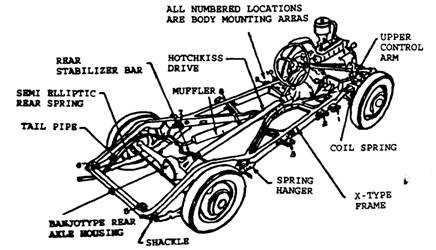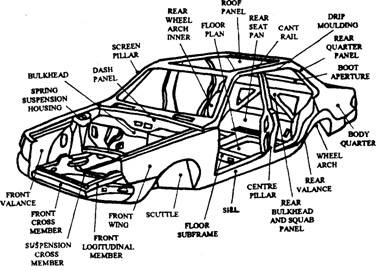1.8. Main Parts of the Automobile
The modern automobile can be categorised into two distinct sub-assemblies, the body and
the chassis.
Fig. 1.15. Rigid 4×2 tractor and single-axle 2 articulated trailers.
Fig. 1.16. Rigid 6×4 tractor and tandem-axle 4 articulated trailers.
Fig. 1.17. Rigid 6×2 tractor and tri-axle 6 articulated trailers.
The body. The main function of the body (Fig. 1.18) is to provide comfort and protection to
the passengers besides giving a good look. The body includes the passenger compartment, the
trunk, the bumpers, the fenders, the radiator grill, the hood, interior trim, glass and paint. A
wide variety of body styles, like two doors or four doors, sedans or hardtop, convertible or station
wagons are available for each chassis model.
Fig. 1.18. A car body.
The chassis. The chassis (Fig. 1.19) forms the complete operating unit and is capable of
running with its own power. It is an assembly of a vehicle without body. The chassis includes
frame, wheels, axles, springs, shock absorbers, engine, clutch, gearbox, propeller shaft and
universal joints, differential and half shafts, steering, brakes and accelerator, fuel tank, storage
battery, radiator, and silencer.
The engine is generally located at the front of the vehicle, followed by clutch, gear box,
propeller shaft, universal joint, differnetial, rear axle etc. The drive from the gerabox is
transmitted through a short shaft to the front universal joint of the propeller shaft. From the
propeller shaft it is conveyed to the rear wheels through a sliding splined type of universal joint.
The bevel gear of the short shaft is driven by the rear universal joint. This bevel gear meshes
with a large bevel gear, which drives the two rear axle shafts through the differential gear.
Fig. 1.19. A car chassis.
There are two methods of body and chassis construction, the separate body and chassis
oanstratSML, **** the integral construction. In the separate body and chassis construction, the
bodr is fi™J to the chassis frame by means of a number of body bolts, passing through the base
of the body and the frame. Pads of anti-quake or vibration materials such as rubbers are placed
between the body and the frame at the bolts to prevent quakes and rattles. In the integral
construction, the body and the chassis frame are combined as one eliminating the mountings.
The integral construction is also called as chassis-less or unibody construction.
Unlike commercial vehicles, which have a separate cab attached to a chassis, car bodies are
now mostly of integral construction (Fig. 1.20), which is frameless mono-box construction. These
body shells are made up from pillars, rails, sills, and panels all welded together, and a reinforcing
channel-section under-frame with an extended sub-frame at the front is provided to replace the
chassis.
Fig. 1.20. Integral body construction.






